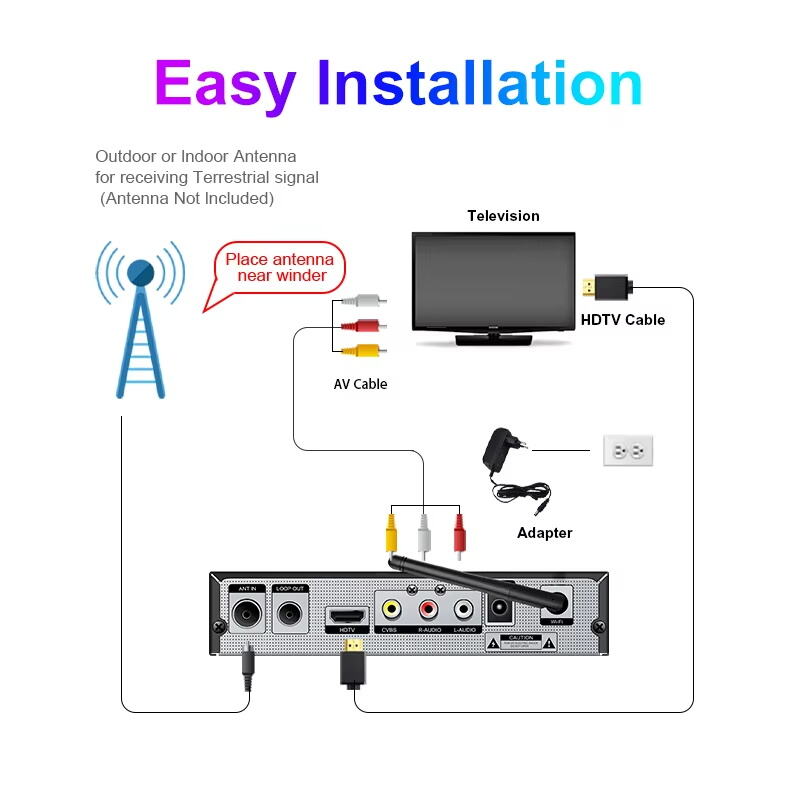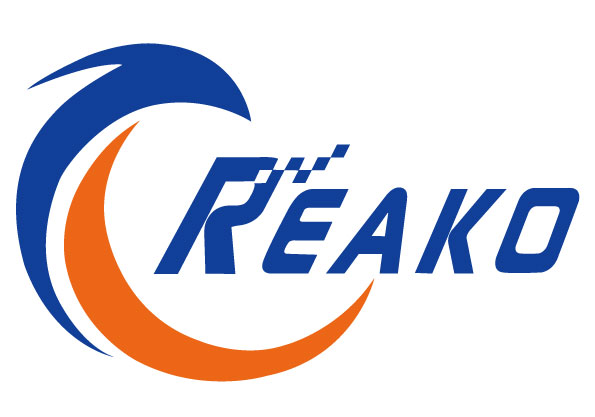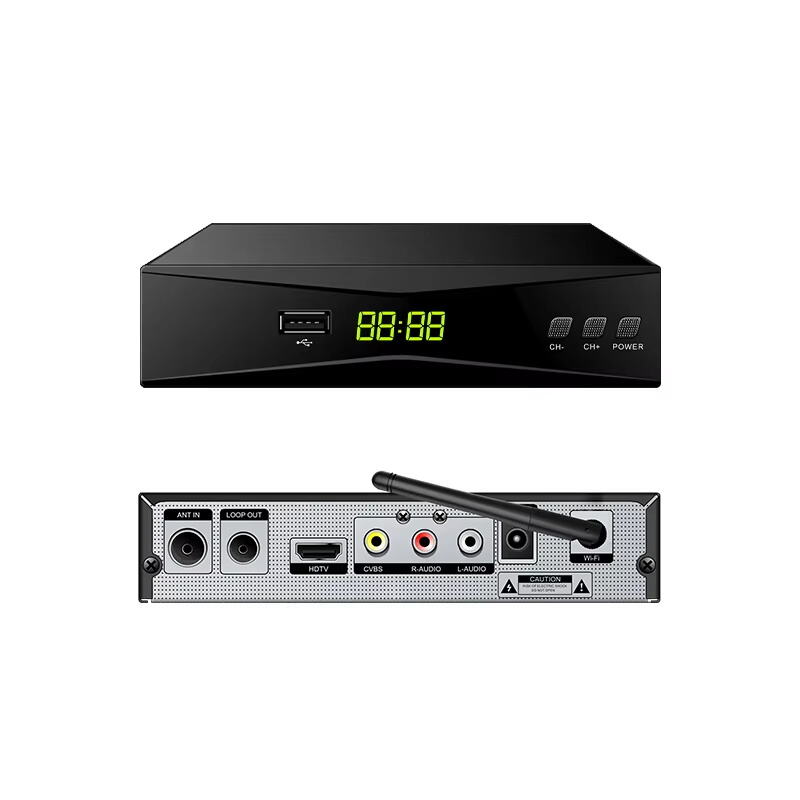Ensuring Proper Ventilation for Your DVB Receiver
Optimal Placement Strategies
Getting good airflow around the DVB receiver makes all the difference for how well it works and how long it lasts. The best spots are usually on open shelves or TV stands where hot air can escape freely instead of getting trapped. When heat builds up somewhere, it naturally wants to go upward, so giving it space helps prevent overheating problems. Keep at least six inches between the receiver and other electronics since they generate their own heat too. Don't put it inside cabinets or behind furniture either because those tight spaces just trap everything together. Also make sure nothing blocks the vents on the sides or back of the unit. Dust tends to collect there over time, especially near entertainment centers, so give those areas a quick wipe down every few months. Clearing out blockages really does help keep things running cooler overall.
Avoiding Heat-Generating Equipment
Keeping a DVB receiver running at its best requires attention to what's going on around it. Things like game systems and audio gear tend to run hot, and their warmth can affect how well the receiver works over time. Putting up some sort of barrier between these heat sources and the receiver helps prevent problems down the road. Checking in on the receiver periodically makes sense too. If someone notices anything odd happening with signal strength or reception quality, moving the device away from heat sources might solve the issue before things get worse. Simple steps like these go a long way toward keeping the system stable and avoiding damage from excessive heat exposure.
DVB Receiver Cleaning and Dust Prevention
Safe Exterior Cleaning Techniques
Keeping the outside of a DVB receiver clean helps it work better and last longer. For dust removal, microfiber cloths are a good choice since rough materials scratch surfaces easily. When wiping down the device, dampening the cloth with just water or maybe a gentle all-purpose cleaner works well, but be careful not to get any moisture inside the ports or around the air vents. Cleaning should happen roughly once or twice per quarter to stop dust from accumulating over time. Too much dust blocking the ventilation can actually cause the unit to overheat eventually. A regular maintenance routine like this keeps the receiver running smoothly for years without unexpected issues cropping up.
Vent and Port Maintenance
Keeping those vents and ports clean on a DVB receiver makes all the difference for good airflow and stopping dust from building up inside. When someone looks at these spots regularly, they often find dust has collected there already. A quick blast from compressed air usually gets rid of most of it, which helps extend how long the device will last before needing repairs or replacement. Most folks should probably give their receiver a good going over about every half year or so to spot anything that might be blocking airflow. Putting some kind of cover over the unit when it's sitting idle is another smart move to keep dust from settling in those open ports. Taking care of this stuff ahead of time means fewer headaches down the road with receivers running hot or shutting off unexpectedly because air just can't get through properly anymore.
Electrical Protection Measures
Surge Protection Solutions
Good surge protection really matters when it comes to keeping a DVB Receiver working properly for years. Getting a decent quality surge protector helps protect the device from those unexpected voltage spikes that happen quite frequently actually about 20 times per year on average in most homes. Storms and power outages tend to cause the worst kind of damage from these electrical surges. Make sure whatever surge protector gets installed can handle the total wattage of everything plugged into it otherwise there might be problems down the road. Most experts recommend replacing surge protectors somewhere between three to five years because those internal parts don't last forever. Regular replacement does more than just save money on repairs though it actually makes the whole house safer electrically speaking too.
Voltage Regulation Importance
Voltage regulation plays a vital role in keeping DVB Receivers running properly over time. Voltage regulators maintain steady power supplies and stop those annoying voltage spikes that might damage sensitive components inside the receiver. According to industry studies, equipment exposed to inconsistent electrical currents faces around 30 percent greater chances of breaking down sooner than expected. For extra protection against these issues, checking voltage levels regularly with an appropriate meter allows technicians to spot problems early on before they cause real damage. Taking this kind of preventive measure not only saves money in repairs but also ensures better long term reliability from the DVB system as a whole.
Firmware Maintenance and Updates
Checking for Updates
Keeping track of firmware updates matters a lot when it comes to both how well and securely your DVB receiver works. Companies tend to put out fixes regularly that solve problems, boost performance, sometimes even throw in cool new stuff. Most folks check for these updates either by visiting the company site directly or looking around in their device menu options. Some devices let users turn on auto-updates which saves headaches later since everything stays up to date automatically. Another good idea? Join online communities where people talk shop about all things related to their receivers. These forums are gold mines for info on what updates are worth installing and when might be the best time to do so without messing up anything else going on with the setup.
Safe Installation Procedures
A safe firmware update installation keeps DVB receivers protected against possible damage. Always stick closely to what the manufacturer says when doing these updates, because mistakes happen and can lead to something called bricking where the device becomes completely useless. Backup all existing settings before starting the update process. Having those saved makes recovery much easier if anything goes wrong along the way. After finishing the installation, check how well the DVB receiver works right away. This confirms whether the update went through properly and ensures everything functions as expected going forward.

Connection and Cable Management
Organizing Cables Properly
Good cable management makes things look nicer and works better too. Cable ties and clips work wonders for keeping everything neat and tidy without all those annoying knots and mess. Most people find it helpful to take a look at their cables once a year just to rearrange anything that might have gotten out of place. Another important thing? Keep cables away from other electronics since some gadgets emit signals that can mess with the quality of what runs through the wires. Checking cables regularly isn't just about appearances either. Frayed or damaged wiring needs replacing fast before it becomes a fire hazard. Safety first always applies when dealing with electricity after all.
Checking Connection Integrity
Keeping those connections solid is really important if we want things to work right. Check all the links regularly to make sure nothing's coming loose or getting rusty. A lot of folks don't realize how much difference a single bad connection can make to overall performance. Most modern DVB receivers come with some kind of signal testing tool built in, and there are plenty of third party apps out there too that can give a good read on connection strength. When something starts acting up, it pays to write down exactly what happens and which connections were involved at the time. This kind of record keeping makes finding the problem so much easier later on. The whole point is maintaining that strong signal throughout the system while stopping small problems before they turn into big headaches down the road.
Professional Maintenance and Troubleshooting
When to Seek Expert Help
Knowing when to get professional help for a DVB receiver makes all the difference in keeping it running smoothly. Watch out for red flags like constant overheating problems, strange software glitches, or just plain poor performance compared to what it used to do. If any of these happen regularly, don't wait around hoping things will fix themselves. Find someone qualified who actually knows their way around these receivers and can spot problems before they turn into bigger headaches. Check online reviews for local repair shops or post questions on tech forums where real users share their experiences. For older units, setting up regular checkups once or twice a year isn't a bad idea either. This kind of maintenance keeps those receivers working properly instead of letting small issues become major repair jobs down the road.
Recognizing Warning Signs
Spotting problems early with a DVB receiver saves money and headaches down the road. Watch out for strange sounds coming from the device, random power-offs, or error messages popping up on screen these usually point to something going wrong inside. Keeping track of what happens when these issues occur gives technicians better clues later on. Check how well the receiver performs day after day too. If there's a noticeable drop in signal quality or reception problems start appearing regularly, that's probably a sign things need looking at by someone who knows what they're doing. Learning about typical problems that happen with these devices makes all the difference when deciding whether to call in outside help. Taking this kind of hands-on approach cuts down on waiting around for repairs and keeps the receiver working properly for longer periods.
FAQs
What is the best way to position my DVB receiver for optimal ventilation?
Position your DVB receiver on open shelves or TV stands, ensuring at least six inches of distance from other electronics. Avoid closed spaces and ensure that ventilation grilles are unobstructed.
How can I protect my DVB receiver from power surges?
Using a high-quality surge protector can shield your DVB Receiver from voltage spikes. Ensure it's rated for combined wattage and replace it every 3-5 years for maximum protection.
Why is regular firmware updating necessary for DVB receivers?
Firmware updates often address security vulnerabilities, fix bugs, and improve performance. Regular updates ensure your receiver functions optimally and securely.
How can I avoid overheating in my DVB receiver?
Avoid placing your receiver near heat-generating equipment like gaming consoles. Use heat shields if necessary and monitor its performance for any signs of heat stress.


